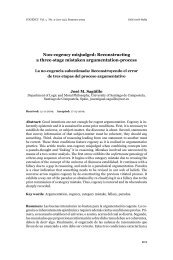Cogency v2 n2
Cogency v2 n2
Cogency v2 n2
Create successful ePaper yourself
Turn your PDF publications into a flip-book with our unique Google optimized e-Paper software.
“A picture held us Captive”: The later Wittgenstein... / S. W. PATTERSON<br />
the image) or that one may interpret the figure as a rabbit (in which case<br />
one forms the inner picture of a rabbit when looking at the image). Why is<br />
this problematic? Seligman, drawing on an earlier account by Aldrich, explains<br />
it this way:<br />
All that this talk of inner pictures seems to get us is now two ‘private’<br />
pictures–one, the ‘pure visual content’ and the other the ‘interpreted<br />
mental content’. And now we are worse off than before. Where we at<br />
least had criteria for what constitutes an interpretation, we are now faced<br />
with an image of such a mysterious sort that we cannot isolate any unique<br />
criteria for its presence or absence. The only criteria is what we say, and<br />
what we say is exactly what we would say if the object itself had actually<br />
altered. (Seligman 1976: 211)<br />
The problem, of course, is that the object hasn’t altered in the slightest.<br />
Seligman continues:<br />
Wittgenstein has tried to rule out in his characteristic fashion, explanations<br />
of the concept of “seeing” and “seeing as” which appeal to ‘inner<br />
pictures’ or private images. [...] The objective was to give the lie to any<br />
philosophical theories which might rest upon a notion of seeing which<br />
requires a ‘pure visual element’ and an accompanying element of ‘interpretation’.<br />
In the cases of seeing-as where such a two-element theory of<br />
seeing seems most at home it fails. And Wittgenstein’s point seems to be<br />
that if it will not work here, it will not work at all. (Seligman 1976: 212)<br />
So “seeing as” is not a matter of interpretation. What is it then? For clearly<br />
something is going on when we consider the shift engendered by images<br />
like the duck-rabbit. Seligman, following Wittgenstein’s remarks about the<br />
image of a Necker cube a proposes that to “see the image as” is to have the<br />
capacity to form counterfactual contexts in which to locate the various aspects<br />
it appears to take on, for example to see the cube as if from above, or<br />
as if from below. We need not do this in every case, says Seligman, it is<br />
enough for the seeing of an aspect that we could do it. This is not as puzzling<br />
a notion as it may seem, for it returns us to the Brown Book notion of “fit”<br />
with which we began the investigation into picturing. To see an aspect is<br />
phenomenologically similar to the “puzzle-piece” epistemic feeling gener-<br />
117








